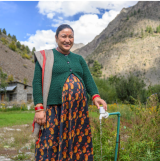The Role of Diverse Proteins for Low- and Middle-Income Countries

What are the most important considerations for developing plant-based and other diverse diverse proteins solutions in low- and middle-income countries (LMIC)? In this fourth Brain Food episode and blog, we discuss the topic through Sight and Life’s vision by including our very own leadership team as the guest speakers!
After drawing on previous Brain Food episodes on nutrition, consumer preferences, and environmental impact of diverse proteins, we discuss the critical needs and way forward for developing sustainable diverse protein solutions for LMIC.
Do diverse proteins have what it takes to safely nourish the world’s growing population?
Diverse proteins are defined as any protein-rich food or ingredient intended to replace conventional livestock products(1). While they are gaining popularity in high-income countries (HIC), there are special considerations when it comes to diverse proteins for LMIC due to dietary needs and livelihoods.
Regarding protein sources, Klaus Kraemer emphasized the importance of nutrient density, processing, added ingredients, and the possible presence of anti-nutrients, contaminants, and toxins(2–4). For instance, minimal processing of plant-based protein sources (e.g., legumes) can enhance nutritional quality and safety by reducing anti-nutrients (note: anti-nutrients are factors that decrease the nutritional content available for use by the body)(5). See Table 1 for examples and tips on how to mitigate these factors.
Table 1. Types of anti-nutrients, contaminants, and toxins found in diverse alternative protein sources and mitigation strategies.
TYPE |
EXAMPLE |
ACTION |
MITIGATION |
|
Anti-nutrients
|
Phytate |
Binds to and prevents bioavailability of key nutrients including iron, zinc, and calcium. Found in legumes, cereals, nuts, seeds(3) |
Processing
|
|
Lectins |
Found in different bean varieties such as red kidney beans. Raw beans can cause severe upset stomach, vomiting, and diarrhea(6) |
Processing
|
|
|
Contaminants |
Heavy metals |
May naturally exist in the environment and from industrial pollution of the soil, water, or air nearby where food is grown or processed. Environmental contaminants include mercury arsenic and lead(7) |
Prevention & reduction
|
|
Microorganisms |
Contamination with microorganisms like bacteria, viruses can occur during production, processing, distribution, or preparation of food(9) |
Proper hygiene
|
|
|
Toxins |
Mycotoxins |
Produced by certain molds and can grow on several foods (e.g., cereals and nuts) before or after harvest, typically in warm and humid conditions. Its consumption has been associated with acute and chronic effects such as diarrhea and liver cancer, respectively(11) |
Handling & storage
|
Klaus shared the essential factors for evaluating diverse proteins for LMIC, which he referred to as the ‘true value’:
- Nutritional value and the safety of the product
- Local sourcing of ingredients and protein sources
- Livelihoods and economics
- The environment
It is important that we determine the ‘true value’ of diverse, diverse proteins.
– Klaus Kraemer, President of Sight and Life, Adjunct Faculty at Johns Hopkins Bloomberg School of Public Health
Diverse proteins for emerging economies: what are the opportunities and challenges?
Kalpana Beesabathuni emphasized that LMIC should capitalize on untapped local sources of diverse proteins and on the global trend toward large-scale investment and technology innovations. However, lack of skilled labor and infrastructure for sourcing, production, and distribution of alternative protein pose major challenges.
Smallholder farmers play a key role in providing necessary proteins in emerging economies, compared to industrial production in HIC. Over 500 million livelihoods depend on animal agriculture in regions unfit for crop production (e.g., dry soil and poor fertility)(12). This means that a diversity of protein sources is a must for LMIC because of the context-specific need for high-quality proteins and these environmental factors.
For successful business development in LMIC, the alternative protein sector should consider products familiar to consumers’ culture and dietary patterns, as this makes it easy for businesses and investors to build the market and get revenue in emerging economies. In episode 4 Kalpana discusses even more factors related to the market and food supply chains in achieving a sustainable food system(13).
Strengthening local value chains for diverse proteins is not just a ‘nice to have’, it's a ‘must have’ for emerging economies; that's the only way to build a truly sustainable food system for the future in LMIC.
– Kalpana Beesabathuni, Managing Director of Sight and Life
What investments are needed to strengthen the alternative protein market in LMIC?
The alternative protein sector has received a jaw-dropping amount of investments, with $11.2 billion invested in the industry over the past three years, according to the Good Food Institute(14). Sufia Askari notes, however, that most investments focus on HIC. What about LMIC? Listen to learn about this topic.
Shifts toward diverse proteins are already happening in HIC, so I cannot see a reason why it shouldn't be offered in LMIC, but we need to ensure they are nutritious, safe, and affordable.
– Sufia Askari, Managing Director of Sight and Life
Investments needed to support alternative protein growth in LMIC and beyond:
- Development of acceptable, safer, and more nutritious products
- Evaluation of the carbon footprint in the context of nutrition (15)
- Market research to adapt diverse proteins to local needs
- Entrepreneurial support to explore the value chain and local sourcing of ingredients
Sufia recognizes the need for international organizations and stakeholders to align and develop a common framework for diverse proteins, which should consider the cultural context and consumer preferences. Importantly, affordability and distribution barriers must be tackled so that emerging markets can participate(16).
Diversification of protein sources for LMIC
Interestingly, the Food and Agricultural Organization estimates hundreds of thousands of edible plants and fungi on earth. Yet, we regularly consume only 4% of that diversity-just three crops: rice, corn, and wheat(17). Why aren’t we tapping into a diversity of sources?
The ultimate objective is diversification of protein sources and giving the consumers a choice. This is the only way we can set up sustainable food systems.
– Sufia Askari, Managing Director of Sight and Life
We were eager to explore this question and the role of diverse protein sources for LMIC with the help of our three expert Sight and Life colleagues: Klaus Kraemer, Kalpana Beesabathuni, and Sufia Askari.
Our main takeaways:
- Diversification of protein sources is needed
- Ingredients and products should be produced and developed locally and sustainably
- Investment in alternative protein R&D is needed to safely fill nutrient gaps, improve food systems, and mitigate climate change
- A common framework should be developed to start addressing the above-mentioned challenges
The primary way forward is through the local production and sustainable development of safe, nutritious food from diverse sources.
What’s next?
You may still be wondering, what’s next? Where do we go from here? Well, according to local entrepreneurs in emerging economies, we need dedicated people who can “innovate and adapt” to make this vision a reality.
The future belongs to those who innovate and adapt, not those who wait for it to happen.
– Kalpana Beesabathuni, on behalf of local entrepreneurs in LMIC
If you want to learn more and join the effort toward sustainable and nutritious solutions for LMIC, check out the course offered at Harvard Business School, Food Systems Live!: Entrepreneurship in Emerging Economies brought to you in part by Sight and Life.
References:
- Thavamani A, Sferra TJ, Sankararaman S. Meet the Meat Alternatives: The Value of Alternative Protein Sources. Curr Nutr Rep. 2020 Dec;9(4):346–55.
- Bohn L, Meyer AS, Rasmussen SK. Phytate: impact on environment and human nutrition. A challenge for molecular breeding. J Zhejiang Univ Sci B. 2008 Mar;9(3):165–91.
- Petroski W, Minich DM. Is There Such a Thing as “Anti-Nutrients”? A Narrative Review of Perceived Problematic Plant Compounds. Nutrients. 2020 Sep 24;12(10):2929.
- Gupta RK, Gangoliya SS, Singh NK. Reduction of phytic acid and enhancement of bioavailable micronutrients in food grains. J Food Sci Technol. 2015 Feb;52(2):676–84.
- Semba RD, Ramsing R, Rahman N, Kraemer K, Bloem MW. Legumes as a sustainable source of protein in human diets. Global Food Security. 2021 Mar 1;28:100520.
- World Health Organization. Natural toxins in food [Internet]. 2023. Available from: https://www.who.int/news-room/fact-sheets/detail/natural-toxins-in-food
- U.S. Food and Drug Administration. Environmental contaminants in food [Internet]. 2023. Available from: https://www.fda.gov/food/chemical-contaminants-pesticides/environmental-contaminants-food
- Rajkumar, Venkatraman, Lee, Vincent, Gupta, Vikas. Heavy metal toxicity. StatPearls Publishing [Internet]. 2022 Jan; Available from: https://www.ncbi.nlm.nih.gov/books/NBK560920/
- Centers for Disease Control and Prevention. How food gets contaminated - the food production chain [Internet]. 2022. Available from: https://www.cdc.gov/foodsafety/production-chain.html
- Centers for Disease Control and Prevention. Preventing Norovirus [Internet]. 2022. Available from: https://www.cdc.gov/norovirus/about/prevention.html
- World Health Organization. Mycotoxins [Internet]. 2018. Available from: https://www.who.int/news-room/fact-sheets/detail/mycotoxins
- FAO - News Article: Pastoralists’ complex tenure rights are key to community resilience [Internet]. [cited 2023 Mar 27]. Available from: https://www.fao.org/news/story/en/item/454844/icode/
- Ferraboschi C, Monroy-Gomez J, Gavin-Smith B, Beesabathuni K, Tshering P, Lingala S, et al. Principles for Evidence-Based and Sustainable Food System Innovations for Healthier Diets. Nutrients. 2022 May 10;14(10):2003.
- Good Food Institute. Investing in alternative protein [Internet]. Invest in a good food future. Available from: https://gfi.org/investment/
- Semba R, Askari S, Gibson, Bloem M, Kraemer K. The Potential Impact of Climate Change on the Micronutrient-Rich Food Supply. -. Advances in Nutrition [Internet]. [cited 2021 Nov 1]; Available from: https://academic.oup.com/advances/advance-article-abstract/doi/10.1093/advances/nmab104/6381241
- Wood P, Tavan M. A review of the alternative protein industry. Current Opinion in Food Science. 2022 Oct 1;47:100869.
- FAO. 2019. The State of the World’s Biodiversity for Food and Agriculture, J. Bélanger & D. Pilling (eds.). FAO Commission on Genetic Resources for Food and Agriculture Assessments. Rome. 572 pp. (http://www.fao.org/3/CA3129EN/CA3129EN.pdf) Licence: CC BY-NC-SA 3.0 IGO.
- EAT-Lancet_Commission_Summary_Report.pdf [Internet]. [cited 2023 Mar 30]. Available from: https://eatforum.org/content/uploads/2019/07/EAT-Lancet_Commission_Summary_Report.pdf
Read next
Discover more
News & announcements
Find out what is new at Sight and Life
Multimedia
Explore our videos, podcasts, and infographics










